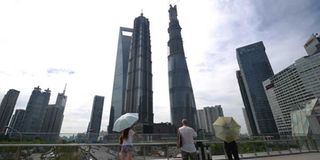Man can build grand cities but nature determines their future

Visitors look at the Shanghai Tower (C-R) in Shanghai, China on August 3, 2013. The lesson of Mesa Verde is that man can build the grandest cities and have the grandest plans for the future. But the final outcome of a civilisation is often dependent on nature. AFP PHOTO | Peter PARKS
What you need to know:
- The lifespan in those times was about 25 years for women and 35 for men. Childbirth was often fatal.
- As I toured the site with European, Asian and American tourists, I thought of the ancient Greek travel writer Herodotus, who lived in the fifth century before Christ. He chronicled large civilisations that are no longer on any map.
As you approach one of America’s most historic sites, Mesa Verde, you must drive through hundreds of acres of burned forest. The trees are like skeletons on a landscape that was once a lush centre of Indian agriculture.
Mesa Verde, which means green table, is the site of over 15,000 structures built between 900 and 1200 AD. These grand homes sit below the mesa, carved into the alcoves of the sandstone cliffs below.
Visitors from around the world come to see these remnants of a spectacular civilisation and try to learn what they can teach us today. It was the reason that I made the trek to this beautiful but isolated place in southwestern Colorado this week.
GREAT DEPRESSION
Taking a guided tour through Cliff House, I walked down several hundred feet of stairs built into the side of cliffs by preservationists during the Great Depression in the 1930s. I then climbed a 15-foot ladder into dwellings, carefully and artfully sculpted with sandstone bricks, stone and plaster, some several stories high.
Nobody knows where these people came from, but two theories are popular. One suggests that they were descendants of those who crossed the great land bridge that once spanned Russia and America. Others say they came from the Africa-Latin America land mass that was once one continent.
The Indians came to this area for two reasons. They could grow crops — mostly corn and squash — on the rich mesa above their cliff dwellings. They could get fresh water from the alcoves in the cliffs below because it was slowly filtered from the mesa through the porous sandstone.
The lifespan in those times was about 25 years for women and 35 for men. Childbirth was often fatal. While the diet of cornmeal was healthy, it was ground on sandstone. Sand particles in food caused problems for teeth and digestive systems.
Nobody knows why these Pueblo people left. Since their descendants can be found along the Rio Grande and other rivers in Southwest America, one thought is that lack of water might have instigated a migration.
As I toured the site with European, Asian and American tourists, I thought of the ancient Greek travel writer Herodotus, who lived in the fifth century before Christ. He chronicled large civilisations that are no longer on any map.
I also thought of the quarter-million pine trees in Colorado that have been killed by a beetle that used to be killed by cold winters. Climate change has now allowed the beetles to work non-stop, and I passed by hundreds of mountainsides near Mesa Verde that were covered with dead trees.
The trees that top Mesa Verde, burned by a fire started by lightning, will likely not re-establish themselves completely for 200 years, according to forest rangers. And that is if there is no further change in temperatures in the area.
The lesson of Mesa Verde is that man can build the grandest cities and have the grandest plans for the future. But the final outcome of a civilisation is often dependent on nature — the changing courses of a river, the infestation of disease and temperature fluctuations. It is a humbling reality to contemplate.




